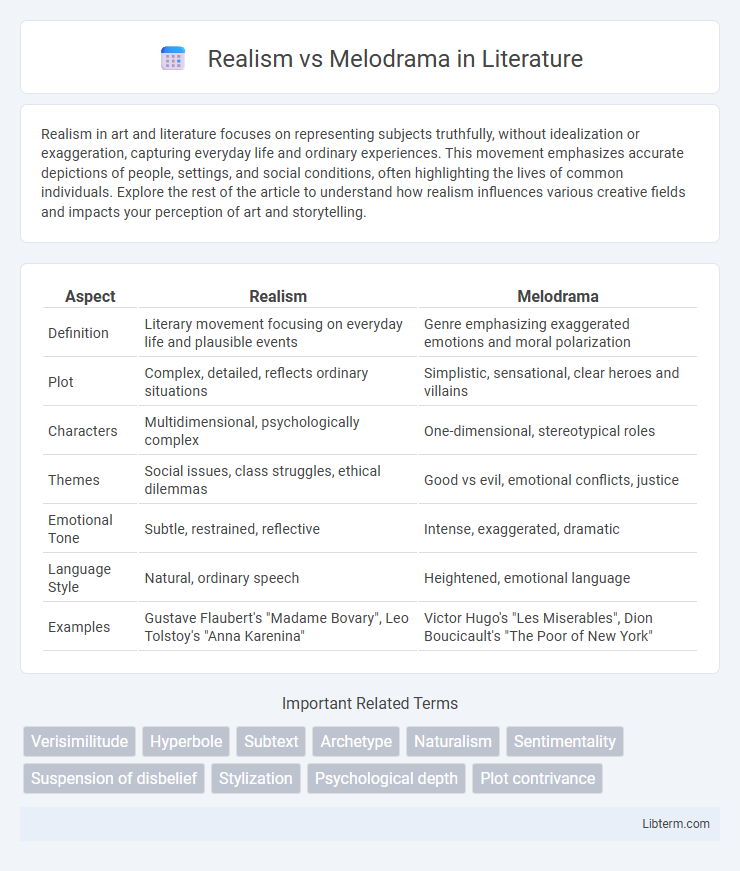Realism in art and literature focuses on representing subjects truthfully, without idealization or exaggeration, capturing everyday life and ordinary experiences. This movement emphasizes accurate depictions of people, settings, and social conditions, often highlighting the lives of common individuals. Explore the rest of the article to understand how realism influences various creative fields and impacts your perception of art and storytelling.
Table of Comparison
| Aspect | Realism | Melodrama |
|---|---|---|
| Definition | Literary movement focusing on everyday life and plausible events | Genre emphasizing exaggerated emotions and moral polarization |
| Plot | Complex, detailed, reflects ordinary situations | Simplistic, sensational, clear heroes and villains |
| Characters | Multidimensional, psychologically complex | One-dimensional, stereotypical roles |
| Themes | Social issues, class struggles, ethical dilemmas | Good vs evil, emotional conflicts, justice |
| Emotional Tone | Subtle, restrained, reflective | Intense, exaggerated, dramatic |
| Language Style | Natural, ordinary speech | Heightened, emotional language |
| Examples | Gustave Flaubert's "Madame Bovary", Leo Tolstoy's "Anna Karenina" | Victor Hugo's "Les Miserables", Dion Boucicault's "The Poor of New York" |
Introduction to Realism and Melodrama
Realism and melodrama represent two distinct approaches in literature and theater, with realism emphasizing authentic, everyday experiences and characters portrayed with psychological depth. Realism seeks to depict life accurately, focusing on plausible situations and social issues without exaggeration. In contrast, melodrama is characterized by exaggerated characters and sensational plots designed to appeal to emotions, often highlighting clear distinctions between good and evil.
Defining Key Characteristics
Realism emphasizes authentic representation of everyday life, featuring complex characters, natural dialogue, and plausible situations that mirror social realities. Melodrama relies on exaggerated emotions, clear moral distinctions between good and evil, and sensational plot twists designed to evoke strong emotional responses. Both genres use narrative techniques to engage audiences, but realism prioritizes subtlety and psychological depth, whereas melodrama focuses on heightened dramatic effects and emotional appeal.
Historical Origins and Development
Realism, emerging in mid-19th century France with pioneers like Gustave Flaubert and Honore de Balzac, aimed to depict everyday life and society with accurate, unembellished detail. Melodrama originated earlier in the 18th century, characterized by exaggerated characters and sensational plots designed to evoke strong emotions, gaining prominence in theater and early cinema. The development of Realism fostered a shift from Melodrama's theatrical exaggeration toward more nuanced storytelling reflecting social issues and psychological depth.
Core Themes and Motifs
Realism prioritizes authentic portrayal of everyday life, emphasizing nuanced human experiences, social conditions, and psychological depth, whereas melodrama relies on exaggerated emotions and clear moral distinctions to engage audiences. Core themes in realism include social critique, ethical ambiguity, and character complexity, while melodrama often centers on good versus evil, heightened conflict, and emotional spectacle. Motifs in realism feature ordinary settings and subtle dialogue, contrasting with melodrama's use of dramatic music, stark contrasts, and symbolic characters.
Narrative Structure and Plot Devices
Realism emphasizes a narrative structure grounded in everyday life, featuring complex characters facing plausible conflicts that reflect authentic human experiences. Melodrama relies on exaggerated plot devices such as heightened emotional situations, clear moral distinctions, and dramatic twists to evoke strong audience reactions. While realism often employs subtle, open-ended resolutions, melodrama favors decisive conclusions with pronounced emotional payoff.
Characterization Approaches
Realism emphasizes authentic, complex characters shaped by everyday experiences and social environments, prioritizing subtlety and psychological depth in characterization. Melodrama, in contrast, portrays characters with exaggerated emotions and clear moral distinctions, often embodying archetypal roles such as heroes, villains, and victims to evoke strong emotional responses. The characterization approach in Realism seeks nuanced human behavior, while Melodrama relies on dramatic and heightened traits to drive the narrative.
Emotional Engagement: Subtlety vs Exaggeration
Realism in film emphasizes emotional engagement through subtle expressions and nuanced character development, creating an authentic connection with the audience. Melodrama relies on exaggerated emotions and dramatic situations to evoke a heightened emotional response, often using clear moral distinctions to amplify intensity. This contrast shapes viewers' experiences by either fostering introspective empathy or evoking overt emotional reactions.
Visual and Stylistic Elements
Realism employs natural lighting, muted color palettes, and unembellished set designs to create an authentic and immersive visual experience, emphasizing everyday life and subtle emotional expression. Melodrama, on the other hand, uses heightened color saturation, dramatic lighting contrasts, and exaggerated mise-en-scene to intensify emotional impact and underscore moral conflicts. The stark visual disparities between realism's restrained aesthetics and melodrama's stylized flamboyance serve to reinforce their distinct narrative aims and audience engagement strategies.
Impact on Audience Perception
Realism in film and literature fosters audience perception through authentic representation, encouraging viewers to connect with characters and situations on a psychological level. Melodrama, characterized by exaggerated emotions and moral polarization, heightens emotional responses and often guides audience sympathy towards clear heroes and villains. This contrast shapes engagement, where realism prompts reflection and critical thinking, while melodrama amplifies emotional impact and immediate investment.
Realism vs Melodrama in Contemporary Media
Realism in contemporary media emphasizes authentic portrayals of everyday life, focusing on nuanced characters and plausible storylines that reflect societal issues and human psychology. Melodrama, by contrast, highlights heightened emotions and moral polarization, using exaggerated plots and character archetypes to engage the audience's empathy and suspense. The tension between Realism and Melodrama shapes modern storytelling, influencing genres such as television dramas, films, and digital content to balance emotional appeal with credible representation.
Realism Infographic

 libterm.com
libterm.com